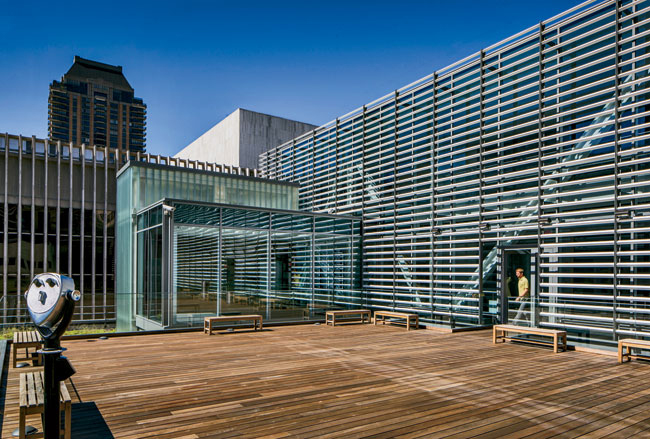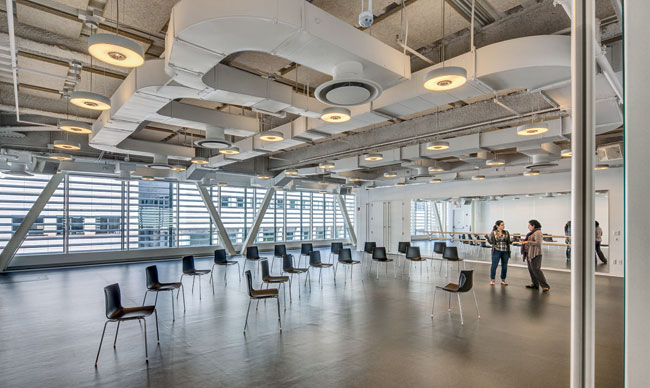Lincoln Center Theater LCT3 by H3 Hardy Collaboration Architecture
New York City

H3’s two-story theater (left) sits on top of the existing Beaumont building in the northwest corner of Lincoln Center. From the upper lobby and terrace, visitors can see the sloping grass-roofed Lincoln restaurant designed by Diller Scofidio + Renfro (2010).

H3’s two-story theater sits on top of the existing Beaumont building (left) in the northwest corner of Lincoln Center. From the upper lobby and terrace, visitors can see the sloping grass-roofed Lincoln restaurant designed by Diller Scofidio + Renfro (2010).
Photo © Ezra Stoller/Esto

An aluminum sunscreen of square tubes rotated at 45 degrees shields the café and public spaces of the elevated theater from the sun. The channel-glass elevator shaft behind the glazed lobby was inserted in the Beaumont by removing coffers from the existing concrete deck of the ceiling structure in the building’s south side. The terrace adjoining the café has an ipe-wood floor.

An aluminum sunscreen of square tubes rotated at 45 degrees shields the café and public spaces of the elevated theater from the sun. The channel-glass elevator shaft behind the glazed lobby was inserted in the Beaumont by removing coffers from the existing concrete deck of the ceiling structure in the building’s south side. The terrace adjoining the café has an ipe-wood floor.

An aluminum sunscreen of square tubes rotated at 45 degrees shields the café and public spaces of the elevated theater from the sun. The channel-glass elevator shaft behind the glazed lobby was inserted in the Beaumont by removing coffers from the existing concrete deck of the ceiling structure in the building’s south side (left). The terrace adjoining the café has an ipe-wood floor.

Next to the black-box Claire Tow Theater is a 1,950- square-foot rehearsal space (left), which receives ample daylight from the north window wall. A café extends from the ticket office across the front of the building.

Next to the black-box Claire Tow Theater (left) is a 1,950- square-foot rehearsal space, which receives ample daylight from the north window wall. A café extends from the ticket office across the front of the building.

A café extends from the ticket office across the front of the building. The café’s cutaway soffit allows daylight to filter down through the space, where a mobile by Kiki Smith hangs.

The structural engineer, Severud Associates, called for two 30-foot-deep, wide-flange longitudinal steel trusses spanning 175 feet for the two-story, rectilinear LCT3 theater. The bridge-like structure, fabricated off-site, matches the span of the existing 18-foot-high, concrete I-shaped girders running across the original Beaumont theater. On the short ends, the trusses are 75 feet long to resist lateral forces, aided by a third long truss. As Severud’s Alvaro Castaño notes, the engineers also reinforced the older girders’ web walls above the existing columns to handle loads from the new structure.
Image courtesy H3 Hardy Collaboration Architecture

1. Elevator lobby
2. Box office
3. Café
4. Terrace
5. Theater seating
6. Rehearsal
7. Green roof
8. Stage
9. Office
10. Backstage
Image courtesy H3 Hardy Collaboration Architecture

1. Elevator lobby
2. Box office
3. Café
4. Terrace
5. Theater seating
6. Rehearsal
7. Green roof
8. Stage
9. Office
10. Backstage
Image courtesy H3 Hardy Collaboration Architecture











Architects & Firms
Judging by Diller Scofidio + Renfro's splashy renovations of and additions to New York's Lincoln Center in recent years, it's surprising that Hugh Hardy and his firm, H3 Hardy Collaboration Architecture, would have added something so discreet to the arts complex. Furthermore, Hardy's sleekly tailored two-story LCT3, which sits atop the existing Vivian Beaumont and Mitzi Newhouse theaters, counters the image of the architect who indelibly forged his career in the 1960s with skewed geometries and brightly colored exposed mechanical ducts. Sure, it's been a while since he founded his own firm in 1962—which became Hardy Holzman Pfeiffer in 1967 and then H3 in 2004. Yet the pop pizzazz that Hardy brought from the start to school, museum, and theater commissions (such as the Playhouse in the Park in Cincinnati, 1968, and the Mt. Healthy School in Columbus, Indiana, 1972) figured prominently in the generational shift away from monotonous corporate Modernism.
Saarinen's original parti for the 1,060-seat Beaumont theater and the 299-seat Newhouse space tucked into the basement had been complicated by its interlocking relationship with the adjoining New York Public Library and Museum of Performing Arts, designed in 1965 by Gordon Bunshaft of Skidmore, Owings & Merrill. While the library has its own entrance pavilion on the south between the Metropolitan Opera House and the theater, the Beaumont's travertine-clad attic conceals the library's book stacks and reading rooms, placed in a square doughnut wrapping around the stage house. Bunshaft's insistence that the Beaumont's concrete columns at the base be few but stalwart disgruntled Saarinen, yet generated a commanding bridgelike structural solution. Massive concrete girders, 18 feet high with an I-beam profile, stretch across the Beaumont for a 175-foot span. Decades later, Hardy and structural engineer Severud Associates would place another long-span steel-truss structure on top to contain a 23,000-square-foot, 112-seat theater. In so doing, H3 pulled the new rectilinear addition 58 feet back from the Beaumont's roof edge both to create an outdoor terrace off the LCT3 lobby and to mitigate the perceived mass of the new 32-foot-high structure when seen from Lincoln Center's north plaza in front of the Beaumont building. “We wanted the steel trusses of the box to have their own identity, yet complement Saarinen's travertine-marble-clad attic sitting on a glass void,” H3 partner Ariel Fausto explains. “That structural conversation is important.”
To lessen the glare on the addition's glazed walls, the architects designed an aluminum screen of square tubes turned at a 45-degree angle. During the day the screen filters light, and at night it becomes a diaphanous veil. The large existing concrete columns allowed H3 to insert two elevator cabs housed in a shaft of channel glass on the south side of the building. All the firm needed to do was to remove three coffers from the concrete deck in the Beaumont's ceiling structure.
Upon arriving at the new upper lobby for the black-box performance space (called the Claire Tow Theater), visitors find a café, which opens onto the terrace. Inside, the theater's fixed seats are upholstered in red, giving the space, with its exposed ceiling, a dramatic punch. The glazed-bar building also contains both a rehearsal room and, above it, administrative offices on the north end.
Preservationists feared that Hardy's addition would mar the quiet monumentality of the Saarinen theater. They needn't have worried. As it turns out, Saarinen's late work is served well by this subtle expansion. It may seem ironic that Hardy would return to a purer Miesian Modernism for this theater, since he had been intent at one time on scrappily playing with the style. But this project proved a wise regeneration for the Beaumont building and for Saarinen's contribution. As Hardy says, “The logic of what we did comes from what he did.”
PeopleArchitect: Engineers: Consultants: Client: General Contractor: Size: Cost: Completion date: |
ProductsMetal/glass curtain wall: Built-up roofing: Channel Glass: Paints and stains: Fixed Theater Seating: |


















